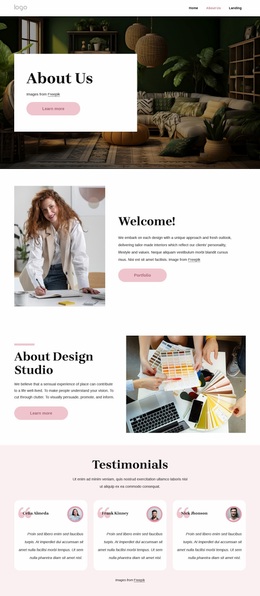Best Practices to Follow for a Successful Website Design Strategy
Best Practices to Follow for a Successful Website Design Strategy
Blog Article
The Ultimate Guide to Modern Website Style Trends
In the ever-evolving digital landscape, modern internet site layout trends play a crucial duty in shaping customer experience and engagement. From the rise of minimalist style concepts that focus on simpleness to the influence of bold typography in defining brand identity, each aspect contributes to a cohesive on-line presence. The emphasis on mobile-first and responsive approaches, together with ingenious microinteractions, even more enhances use. The expanding focus on sustainable internet style techniques mirrors a dedication to environmental duty. These fads collectively increase essential inquiries about the future of reliable website design and what it indicates for companies and consumers alike.
Minimalist Design Principles
Minimal style principles stress the concept that much less is extra, advocating for simpleness and capability in visual interaction. This approach remove unnecessary components, focusing rather on vital components that share the designated message efficiently. By prioritizing clearness, minimal design boosts customer experience, allowing site visitors to browse sites easily.
Core tenets of minimal layout consist of using sufficient white space, which creates a feeling of equilibrium and organization. This adverse room not only routes the customer's attention to crucial elements however also fosters a soothing aesthetic ambience. Furthermore, a limited shade palette is often used, utilizing soft shades or monochromatic systems to preserve aesthetic communication and prevent overwhelming the user.
Typography plays a crucial function in minimalist style, where clear font styles are picked for their simpleness and performance in communicating web content. Inevitably, minimalist design principles cultivate a concentrated atmosphere that encourages customers to involve with the content, improving the total efficiency of contemporary site style.
Vibrant Typography Selections
Embracing bold typography selections has come to be a defining attribute of modern website style, as it properly records focus and communicates solid messaging. Designers are progressively making use of typography not merely as a functional component yet as a crucial aesthetic element that improves the total visual and individual experience.

In addition, the juxtaposition of vibrant typography with minimalist design concepts enables for striking contrasts, boosting readability while preserving aesthetic appeal. Using whitespace around bold message even more stresses its relevance, making sure that the message resonates with the target market.
As digital landscapes end up being much more affordable, leveraging strong typography enables brand names to separate themselves and leave an enduring perception. The cautious option of fonts and their application can stimulate emotions, develop tone, and drive action, making bold typography a vital device in modern-day web site design. Inevitably, it is a powerful way to improve storytelling and ensure that essential messages are not only seen but additionally felt.
Mobile-first and responsive Design
Receptive and mobile-first style has actually arised as an essential principle in modern-day site growth, mirroring the enhancing reliance on mobile gadgets for accessing online content. As customer behavior changes in the direction of mobile browsing, developers should prioritize producing experiences that adapt flawlessly across different screen dimensions and resolutions.
A receptive design ensures that an internet site automatically adjusts its format, images, and functionality based on the tool being utilized. Mobile-first style advocates for creating sites initially for smaller screens, consequently scaling up to larger screens.
Implementing mobile-first and responsive concepts not just deals with user choices yet likewise straightens with search engine optimization (SEARCH ENGINE OPTIMIZATION) techniques. Major search engines, like Google, focus on mobile-friendly internet sites in their rankings, making it essential for organizations to adopt these style approaches. In an affordable digital landscape, embracing responsive and mobile-first style is not just a choice; it is necessary for ensuring ease of access and interaction with a diverse target market.
Involving Microinteractions
Microinteractions play a crucial role in enhancing individual engagement and general site experience, specifically in the context of responsive and mobile-first layout. These subtle style aspects supply immediate comments to users, making communications a lot more user-friendly and pleasurable. Instances consist of button animations, notice notifies, and filling indications, which not just overview users however also produce a sense of link with the interface.
Including appealing microinteractions can considerably enhance functionality visit this website by decreasing cognitive tons. When individuals obtain aesthetic or auditory responses upon doing activities, such as clicking a switch or sending a type, they feel more certain in their selections. This fosters a smoother navigation experience, ultimately enhancing user retention.

As website layout trends remain to advance, the value of microinteractions can not be overstated. They function as the subtle yet effective touchpoints that transform common interactions into extraordinary experiences, therefore boosting the total effectiveness of modern website design.
Sustainable Web Layout Practices
Sustainable website design techniques are becoming increasingly necessary as the electronic landscape grows and environmental issues climb. Programmers and designers are identifying their duty to create internet sites that not just serve individual requirements yet likewise lessen ecological effect. This technique encompasses several vital approaches.
To start with, enhancing energy usage is extremely important. Websites should be made to load swiftly and effectively, which decreases server energy usage and boosts user experience. Methods such as photo compression, decreasing HTTP requests, and making use of modern-day coding practices add significantly to this objective.
Secondly, picking eco-friendly hosting suppliers is important - website design. Lots of holding companies are now powered by sustainable power resources, allowing web sites to run in a much more lasting fashion. This option reflects a commitment to decreasing carbon impacts
Furthermore, taking on a minimalist layout can enhance sustainability. Less elements on a page cause less data transfer, which not just quickens filling times yet additionally conserves sources.
Finally, promoting electronic ease of access guarantees that internet sites reach a bigger target market without unnecessary bloat, aligning user experience with environmental obligation. By integrating these sustainable methods, internet designers can add positively to both individual interaction and the world's well-being.
Conclusion
In recap, modern website design trends stress the assimilation of minimal principles, strong typography, and receptive style to improve customer experience. Embracing these patterns is essential for developing impactful electronic experiences that reverberate with users in a significantly affordable on the internet landscape.
In the ever-evolving digital landscape, modern-day website style patterns site web play an essential role in shaping individual experience and engagement. By prioritizing clarity, minimal layout boosts customer experience, enabling visitors to browse web sites effortlessly.
Eventually, minimal design basics principles cultivate a focused setting that urges users to engage with the web content, boosting the general efficiency of modern internet site style.Microinteractions play an essential function in boosting customer involvement and total site experience, specifically in the context of responsive and mobile-first style.In summary, modern web site design patterns stress the integration of minimal principles, bold typography, and receptive style to boost customer experience.
Report this page